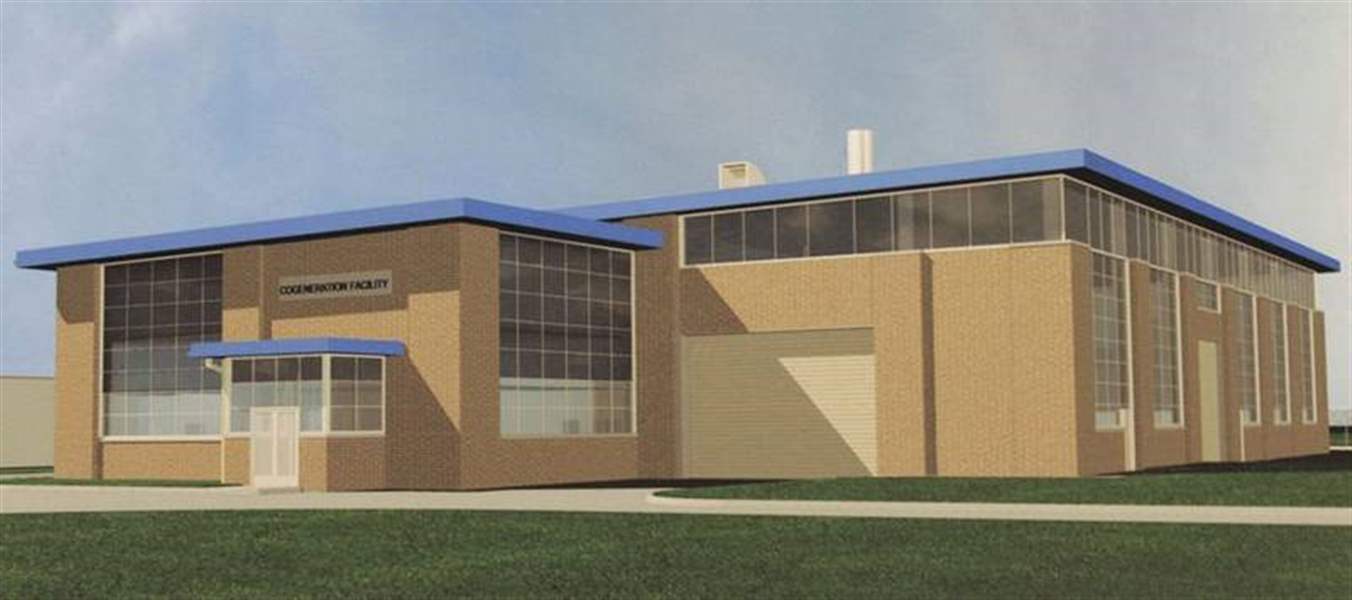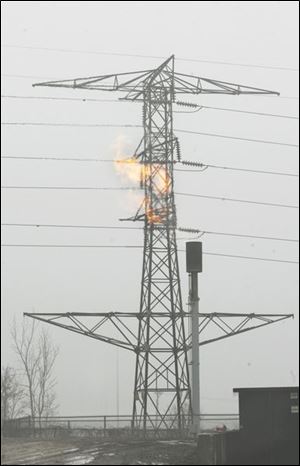
City to convert waste gas from landfill into power
12/11/2007
An artist s rendering shows what the facility to convert methane to energy would look like.

The U.S. Environmental Protection Agency allows the Hoffman Road landfill to flare off methane.
Q. When is a dump not a dump?
A. When officials install more piping and call it a "bio-reactor."
Don't laugh. As Americans strive for energy independence and more ways to curb greenhouse gas emissions, a variety of unconventional power sources - even North Toledo's Hoffman Road landfill - are being viewed with glass-is-half-full potential.
The landfill itself isn't changing. It's the same story there: Garbage in, methane out.
What's new is the $26 million of infrastructure Toledo plans to have installed and operating by the spring of 2009. That includes 1.7 miles of pipeline between the city landfill and its Bay View wastewater treatment plant in Point Place, plus a generator next to that sewage plant.
Methane - one of many greenhouse gases in addition to carbon dioxide attributed to the Earth's warming climate - is a natural by-product of rotting garbage. At the Hoffman Road landfill, officials will capture the methane and pipe it over to the city's wastewater treatment plant, where it will be mixed with methane produced at that site. The combined stream of gas will be used to spin turbines that generate electricity.
The concept has been employed at landfills nationwide, albeit not necessarily in conjunction with a wastewater treatment plant.
The project is expected to generate 7 to 10 megawatts of electricity a day for years, enough to cover the 7 megawatts a day needed to power the wastewater treatment plant and then some, Bob Williams, the city's public utilities director, said.

An artist s rendering shows what the facility to convert methane to energy would look like.
The decision on what to do with the surplus has not been made.
The city could be compensated by FirstEnergy Corp. under Ohio's "net-metering" law for putting its surplus on the region's electrical grid. Or it could make arrangements with the utility to use the surplus for powering other city-owned facilities, Mr. Williams said.
The city expects to save $2 million a year in energy costs by generating its own power for the wastewater treatment plant, he said.
Dave Leffler, the city's solid-waste administrator, said he was half joking when he told reporters they should start referring to the Hoffman Road dump as "a bio-reactor, not a landfill."
"Each of the [landfill] cells is going to be like a fuel cell," he said.
The landfill has enough room left to take garbage for another 28 years based on the current rate of disposal. Methane could be extracted from it beyond 2050, Mr. Leffler said.
Officials have wanted to make some use of the landfill's methane for years, either by themselves or by selling the gas to a private company.
The effort was jump-started with a $1.56 million grant U.S. Rep. Marcy Kaptur (D., Toledo) got for the city in 2003. The bulk of the money, some $24.44 million, is coming from low-interest loans provided by the Ohio Public Works Commission.
Miss Kaptur, who yesterday joined Mayor Carty Finkbeiner at an event to announce the project, said the project provides a little more security during an era of global terrorism.
The vulnerability of the region's electrical grid became an issue after the massive blackout of 2003. By generating some of its own power, the city can be a little more self-reliant, she said.
"We can run the plant completely independent of the grid," Mr. Williams said.
Mr. Finkbeiner said it shows officials are "committed to coming up with innovative ways to treasure [Toledo] while we move our community forward."
Landfills used to vent raw methane to the atmosphere. Then, to at least curb some of the emissions, the U.S. Environmental Protection Agency allowed them to flare off the gas. The agency has encouraged landfill operators to get away from both practices and make beneficial use of methane whenever practical.
Contact Tom Henry at:
thenry@theblade.com
or 419-724-6079.